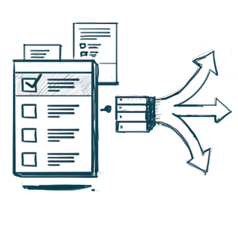Coding for
Good
What we do
DevOps is a way of life in software development. It bridges the gap between development and operations for smoother collaboration, faster updates, and reliable performance as your software grows.
DevOps helps you meet changing demands without ever compromising on quality. It’s the difference between your competitive edge and market vulnerability.
Infrastructure Design:
Your infrastructure should work without interruption: in the cloud, on-premises, or a hybrid setup. That’s why every solution we build is customized to your needs and prioritizes security, efficiency, and scalability. You focus on delivering your promise to the users; we focus on supporting it with solid infrastructure design.
Automation:
Work out the headaches of your software lifecycle with automation tools to support smooth integration, delivery, and deployment. Our automation keeps your projects moving forward.
Monitoring & Maintenance:
Issues are inevitable. Stay ahead with our advanced monitoring and proactive system maintenance. We help to minimize downtime while improving performance and fortifying security.
Our DevOps approach is customizable to your needs and includes the following methodologies:
- Release Management
- Disaster recovery
- Security audits
- Build automation
You get the best tools in the industry, including cloud provider consoles, Terraform for infrastructure, Ansible for configuration, and GitLab/GitHub for version control. Your software development is built to outpace demands and deliver results that matter.
We assign a lean and dedicated DevOps team to each project.
Peak performance and fluid scalability start with a strong infrastructure. Our specialists work alongside your developers and QA engineers so each stage is carefully planned and executed to hit your targets.
Our team has industry-recognized certifications in AWS, Kubernetes, and security, along with cloud and on-premises infrastructure, container orchestration, networking, and data security.
Stay ahead of evolving DevOps technologies with a partner who simplifies the complexity.
Our DevOps model aligns your teams, connects workflows, speeds up deployment, and automates manual tasks. Software engineers become end-to-end developers in the production pipeline.
Stay ahead of evolving DevOps technologies with a partner who simplifies the complexity.
Our DevOps model aligns your teams, connects workflows, speeds up deployment, and automates manual tasks. Software engineers become end-to-end developers in the production pipeline.
Devops, embedded in our Workflow
DevOps requires cultural changes within organizations and the integration of automated processes throughout the development lifecycle.
DevOps is a best practice itself. Market demand responsiveness keeps EdTech companies competitive, but it takes a clear plan and a capable team to execute.
That’s why at Edify we adopt the best practices to optimize our DevOps approach:
Infrastructure as Code (IaC):
Infrastructure as Code (IaC) principles, reduce manual processes and server management overhead. Terraform and Ansible are our go-to packages for managing and provisioning, and version control protocols are the best counterpart for creating repeatable and consistent environments.
Best Practices
Continuous Integration/Continuous Delivery (CI/CD):
CI/CD practices enable faster delivery and increased efficiency by integrating frequent code changes into a shared repository and automating builds, tests, and deployment. This offers a continuous cycle for product rollout and updates.
Security Audits and Patches:
Security prioritization throughout the development lifecycle, with regular security audits and prompt security patches to address vulnerabilities.
Scalability:
Scalability is always in mind. We design and build infrastructure, cloud-based and elastic scaling solutions to accommodate fluctuating workloads and demands.
Monitoring and Logging:
Proactive infrastructure monitoring allows us real-time observability through logs, traces, and metrics. Additionally, alerts notify our team promptly of potential issues.
Failure Tolerance:
Redundancy and failover mechanisms guarantee our systems can withstand failures and maintain availability. These techniques include replicating data across multiple servers and load-balancing.
Daily Backups:
Critical data is backed up daily to protect against data loss and enable quick recovery in the event of unexpected incidents.
User Access Control Best Practices:
Role-based access, multi-factor authentication, and regular access reviews protect sensitive data.
Lengthen your software’s lifespan with DevOps.
Let’s connect!
Check Some of our Success Stories




